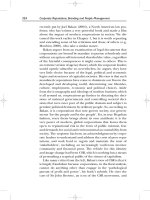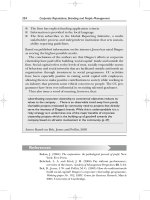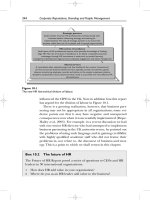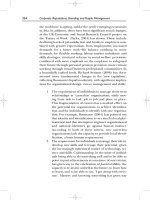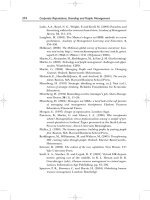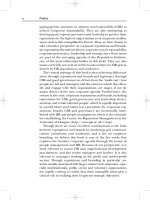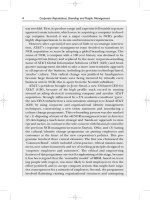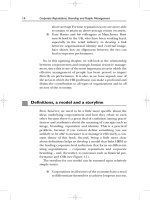Tài liệu Corporate Reputations, Branding and People Management 13 docx
Bạn đang xem bản rút gọn của tài liệu. Xem và tải ngay bản đầy đủ của tài liệu tại đây (125.98 KB, 10 trang )
■ Achieving affinity. It is not enough for customers and
employees (and other stakeholders) to see the corpor-
ate character in the same way; what satisfies them must
be the same to achieve the emotional links, e.g. they
must both value agreeableness or enterprise, and place
a negative value on ruthlessness.
■ Achieving connection. Connections are the logical rea-
sons why employees would want to see satisfied cus-
tomers through, for example, seeing a connection
between their attitudes and behaviours, satisfied cus-
tomers (and other stakeholders) and the financial per-
formance of the company.
We would certainly recommend that organizations wishing
to explore gaps between organizational identity and how out-
siders view an organization’s image (its reputations) might want
to develop a more contextually sensitive adaptation of this
approach. We have begun to do this in a range of contexts,
including a financial services company, a political party and a
voluntary organization (see Box 3.3).
104 Corporate Reputations, Branding and People Management
Box 3.3 Corporate character in a voluntary organization
We undertook a piece of research in 2003 for Age Concern North
Tyneside, a charitable organization in the North of England. The organ-
ization provided a range of services for older people, including sheltered
housing, day care and drop-in centres so that elderly people could get
advice and training on insurance, life-skills, computing etc. The organiza-
tion was part of a larger, well-known national network that had developed
a mission and values framework, but operated relatively autonomously.
Like all charitable organizations, it had to compete for funding with
other charities; it also had to secure competitive contracts with the local
government authority in the area for the provision of services for the eld-
erly, based on negotiated service-level agreements. Thus, in many respects,
it was subject to market-style conditions on pricing and costing, and
on promoting itself as a worthwhile recipient of donations. It also had
to operate in a highly competitive labour market for good quality care
Chapter 3 Organizational identity, action and image: the linchpin 105
workers, nursing staff and administrators to ensure that the service stand-
ards agreed with the local authority were met. However, it had to do
so without the capacity to offer competitive wages and salaries, even at
median local market conditions, since it was poorly funded in compari-
son to nursing homes run directly by the local authority.
The senior management team, comprising a CEO, who was also
on the Board of the national parent organization, Age Concern England,
the finance and operations managers, and the HR manager, were a
well-qualified, enterprising and committed team, who, interestingly, were
all women. Given their problems, they wished to understand more about
the identity-image problem to (a) devise a strategy and set of practices
that would help them ensure that staff were aligned with the values of the
parent group, and (b) help them compete in the local labour market for
good quality staff so that they could achieve better levels of service and
enhance their image with potential funding agencies.
The first stage of the investigative work involved surveying all 120 full-
time employees in groups during working hours, which returned a very
high response rate. We developed a questionnaire based partly on the
corporate character dimensions and items suitably amended for the con-
text. Despite not being able to survey the ‘customers’, many of whom were
too old to complete questionnaires, this approach was deemed highly
appropriate because the values framework mapped directly onto certain
of the corporate character dimensions. The other section of the ques-
tionnaire examined the state of psychological contracts, leadership styles
and communications, and individual identification, which we shall look
at in more detail in Chapter 4.
The results showed that staff as a whole viewed the organization’s
character as competent and agreeable, followed by enterprising, which
mapped onto the parent values of being expert, caring and dynamic,
and which could be treated as proxies for what clients sought. It also
showed, as might be expected, that the organization was neither ruth-
less nor macho. Nor was it seen as particularly informal. However, the
extent of perceived competence and agreeableness among staff was
not particularly high, nor was it universal, since staff at the three dif-
ferent ‘sites’ rated the character of the organization differently. Closer
examination of the state of psychological contracts – what employees
valued about work, what was perceived as ‘promised’ by the organiza-
tion and what was actually delivered in practice – helped shed light on
some of the likely causes, as did this next topic – leadership.
Organizational action: governance,
leadership and engagement
Governance and leadership
To recap on our introduction to these issues in the opening
chapter, we argued that organizational identity deals with the
‘Who are we?’ question and how such conceptions influence
the corporation’s autobiography – its image – cannot be
sustained without supportive organizational actions. Two of the
most important dimensions of organizational action are gover-
nance and leadership. Consider the case of Hurricane Katrina
in Box 3.4.
106 Corporate Reputations, Branding and People Management
Box 3.4 Lessons from failure
At the end of August 2005, Hurricane Katrina devastated the city of New
Orleans and much of the Gulf Coast of the USA killing more than 1000
people and exposing to the rest of the world the inability of America to
act when faced with a crisis that many claimed was foreseeable. Pictures
of a bemused President Bush caught like a rabbit between the lights,
and a disengaged local police force were brought into the living rooms
of billions of people through TV reports and other news media. The dis-
aster provoked a bitter debate about the (lack of) leadership and gov-
ernance displayed by government officials before, during and after the
hurricane, with an array of leaders at various levels of national and state
governance coming in for severe criticism, including President Bush,
Kathleen Babineaux Blanco, the Governor of New Orleans, Mayor Ray
Nagin of New Orleans, Homeland Security Secretary Michael Chertoff
and former Federal Emergency Management Agency director Michael
Brown, who took part of the formal blame for lack of action.
In a discussion at Wharton Business School, the following comments
were made by prominent US academics in response to a question on
whether this was a failure of leadership, or a natural consequence of the
governance structure of the USA, which is split between federal, state and
local officials and the formal protocols that have to be observed between
them, e.g. the state has to formally request Federal assistance.
Chapter 3 Organizational identity, action and image: the linchpin 107
Morris Cohen: [Bush] was very reluctant to [send in troops]. He would
have been roundly criticized. But in hindsight I think he should
have. The resources were sitting there within miles … He, or some-
one, made the wrong decision. And yet it’s an uncertain process. If
the President had been too aggressive, that would have engendered
all kinds of criticism. The next time that leader had to make a deci-
sion, he would be more careful.
Robert Mittelstaedt: Despite all the laws about what a president can or
can’t do – or what approval you need from state governors – when
the chips are down, leaders step up and take action and worry about
the consequences later. Bush should have declared martial law on
Tuesday [30 August, one day after Katrina swept through the city],
sent troops in there and started to marshal resources. Bush’s later
statement [in which he took responsibility for any shortcomings on
the part of the Federal government] was a halfhearted answer. The
picture that comes to mind is Bush reading the little goat book [to
schoolchildren when White House Chief of Staff Andrew Card
informed the president of the terrorist attacks on September 11,
2001]. On Monday [August 29], Bush was in Phoenix talking to people
in an old folks home about his Medicare prescription plan. In both
instances, he ends up with a dumb look on his face. I have never seen
him as a leader. He’s just a politician managed by his handlers. And
I’m a Republican. Imagine if Bush had stepped up on Tuesday [30
August] and sent massive troops in there to evacuate people and
offer medical aid. Suppose afterward you had a congressional investi-
gation into whether he should be impeached for violating the posse
comitatus law [an 1878 statute prohibiting Federal troops from being
used for law enforcement on US soil]. Would he rather have his peo-
ple in front of the commission saying, ‘Didn’t you understand how
bad this crisis was?’ rather than sitting by while people drowned? I’d
much rather be in that position than where he is now. Leaders don’t
worry about consequences. Leaders are born, not made. He has
amazing power but inherently doesn’t have much leadership ability.
There is no leadership test to be elected.
Lawrence Hrebiniak: Our government is decentralized, but only to a
point. We have both centralized and decentralized resources. If that
system is to work, both sides must be well prepared for action. There
108 Corporate Reputations, Branding and People Management
should be some integration between the local and the central level.
Bush should have had the right people in Homeland Security or
FEMA contact these [local and state] people and say, ‘We’ve got a
hurricane coming. Who should respond first? What resources do you
need?’ You talk to them and you find out where they are short of
capabilities and you make up the slack.
In direct response to the question, ‘Was any leadership exhibited in
New Orleans?’, the following comments were made.
Robert Mittelstaedt: Where did leadership show up? The Coast Guard.
They had deployed helicopters to the area, so they were able to move
resources in right behind the storm. That’s why choppers were all over
the place rescuing people. People at the middle level in the Coast Guard
knew it was their responsibility and they just did it. They understood
their mission and they were there and they saved thousands of lives.
K@W: Did the political culture of New Orleans contribute to the fail-
ure of local leadership?
Robert Mittelstaedt: One of my relatives, a judge, once ran for mayor
of New Orleans and lost. The only explanation I had for his loss was that
he was politically connected but not corrupt. It’s a place with a long his-
tory of political corruption and a lack of concern for the broader pub-
lic good. Even with somebody like Nagin, who has made some attempts
to try to improve that environment and go after the corruption, it’s still
far down on the list of cities that have things under control. The poverty
level is horrible. Crime is terrible. The public school system is terrible.
I don’t believe the response [to the aftermath of the storm] was related
to racism; you have seen white flight out of New Orleans for decades.
All of that contributes to an environment where there are no leaders
who can effectively deal with the bulk of the problems, many of which
go back to Huey Long [the corrupt former governor of Louisiana].
It’s been an anti-business state in many ways. The economy is totally
dependent on shipping and tourism. If you don’t have leaders who
want to solve these things, you get what you saw on TV.
Source: Reprinted with permission from ‘A Month After Katrina’,
Knowledge @Wharton, available online at http://knowledge.
wharton.upenn.edu
